This lemon curd cake is so delicious and has the perfect balance of flavor between the bright, tart citrus and fluffy buttercream! It’s my go to summertime cake.
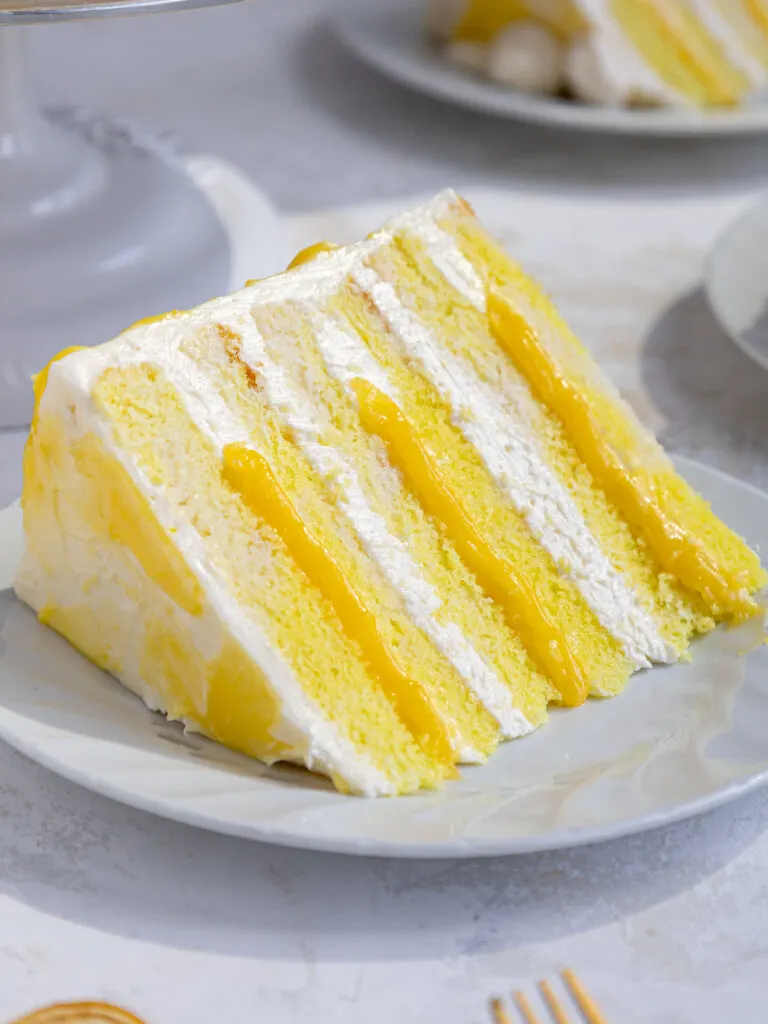
How to Make This Lemon Curd Cake
To make sure this cake turns out as amazing as possible, let’s walk through each step together! I’ve also included a video tutorial of the process below.
I figured it might be helpful to know what tools I use too, so I’ve shared a list below.
Not all of these are mandatory, but they make the process a lot easier. If you don’t have all these things on hand, feel free to improvise and work with what you have.
- Saucepan
- Fine mesh strainer
- Heat-proof bowl
- 3, 8-inch cake pans
- Serrated Knife
- Spinning cake stand
- Electric hand mixer or stand mixer
- 10-inch greaseproof cake board
- Large offset spatula
- 1 Large piping bag
Step 1: Make the Lemon Curd
Make the lemon curd first so that it has time to cool and thicken.
I love making lemon curd with this recipe because it helps use up the egg yolks that would be left over after making the Swiss meringue buttercream.
One quick thing to note! When making the lemon curd, it’s best to use a heat-proof saucepan that’s ceramic as opposed to metal. Some metal pans and sometimes even metal whisks can give the curd a metallic taste.
This lemon curd can be made in advance and stored in the fridge for up to a month.
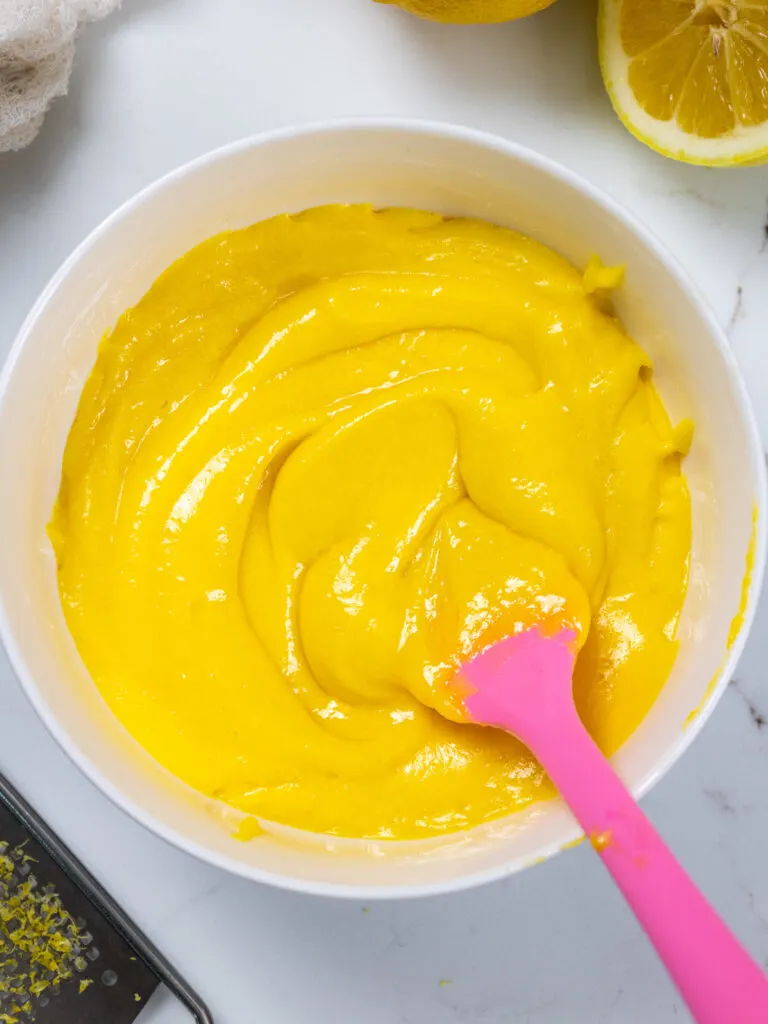
However, if you’re running short on time, you can also use store-bought lemon curd.
Step 2: Bake the Lemon Cake Layers
Then it’s time to make the lemon cake batter following the recipe card at the bottom of this post.
This step is optional, but I like marble a little bit of color in the cake layers. Pour half of the cake batter (about 900g) into a separate bowl and use a small drop of gel food coloring to color one bowl of batter yellow.
Alternate pouring the uncolored and yellow batter into the prepared pans. Use a butter knife or a small offset spatula to swirl the batter together.
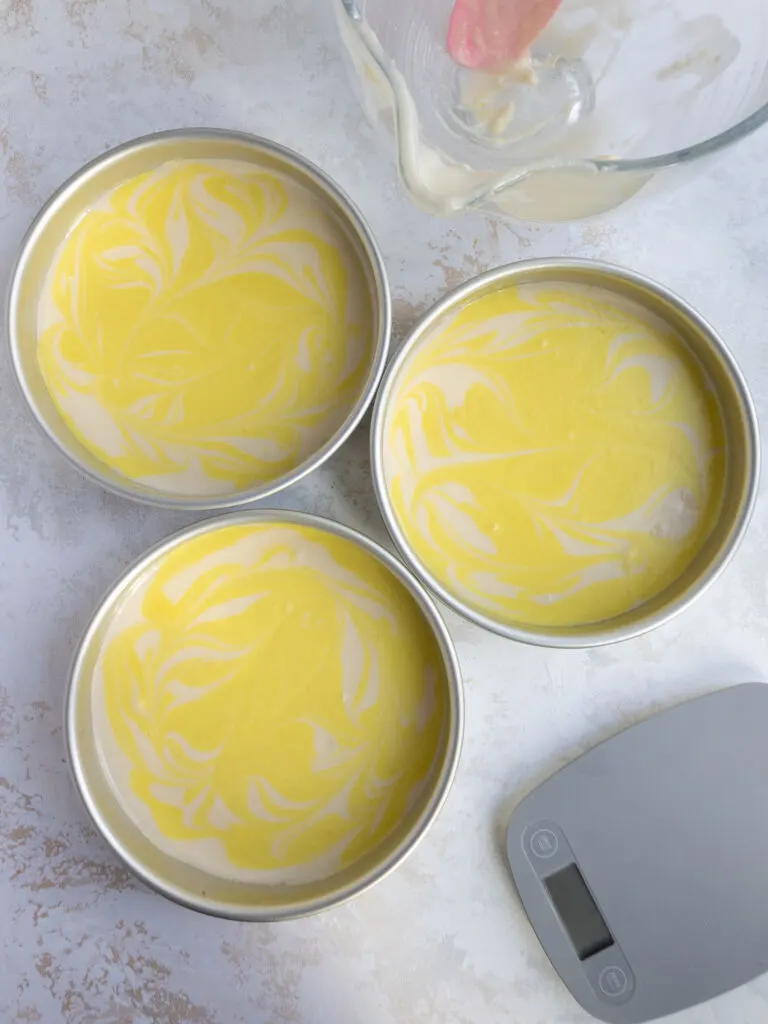
Bake the layers for 33-36 minutes or until a toothpick comes out with a few moist crumbs.
Remove the cake layers from the oven and let them cool in the pans for about 15 minutes.
Gently run an offset spatula around the rim of the cake pans to loosen them, then flip the cake layers onto wire racks to finish cooling. If you’re in a rush (or impatient like me), you can pop the cake pans into the freezer for 30 minutes to accelerate the cooling process.
Once cooled, use a serrated knife to level the top of each layer and remove the caramelization around the sides of the layers.
I also like to torte the cake layers horizontally to create 6 thinner cake layers, but this is optional.
If you make these cake layers in advance and freeze them, let them thaw for about 20 minutes before assembling your cake. The cake layers should still be cold to the touch, which will make it easier to assemble your cake.

Step 3: Make the Lemon Frosting
While the cake layers bake and cool, make the lemon frosting.
I like to use my Swiss meringue buttercream (SMBC) as a base because it isn’t too sweet and really lets the lemon shine through!

If you aren’t a fan of SMBC, I’d recommend adding the lemon zest and extract to a batch of my American buttercream or 1.5 batches of my hybrid buttercream.
This frosting can also be made in advance if needed and kept in the fridge for up to a month.
Step 4: Stack and Fill the Cake Layers
Then it’s time to assemble this cake! Stack and frost the cake layers on a greaseproof cake board or flat plate. Use a dab of buttercream to help stick the first cake layer to the board.
Spread a thin layer of buttercream on top of each cake layer.
Pipe a thick ring of buttercream around the edge of the cake layer and fill the center with lemon curd.
I like to add about 1/3 cup of lemon curd between each layer. Make sure you reserve about 1/4 cup of lemon curd to decorate the cake later.
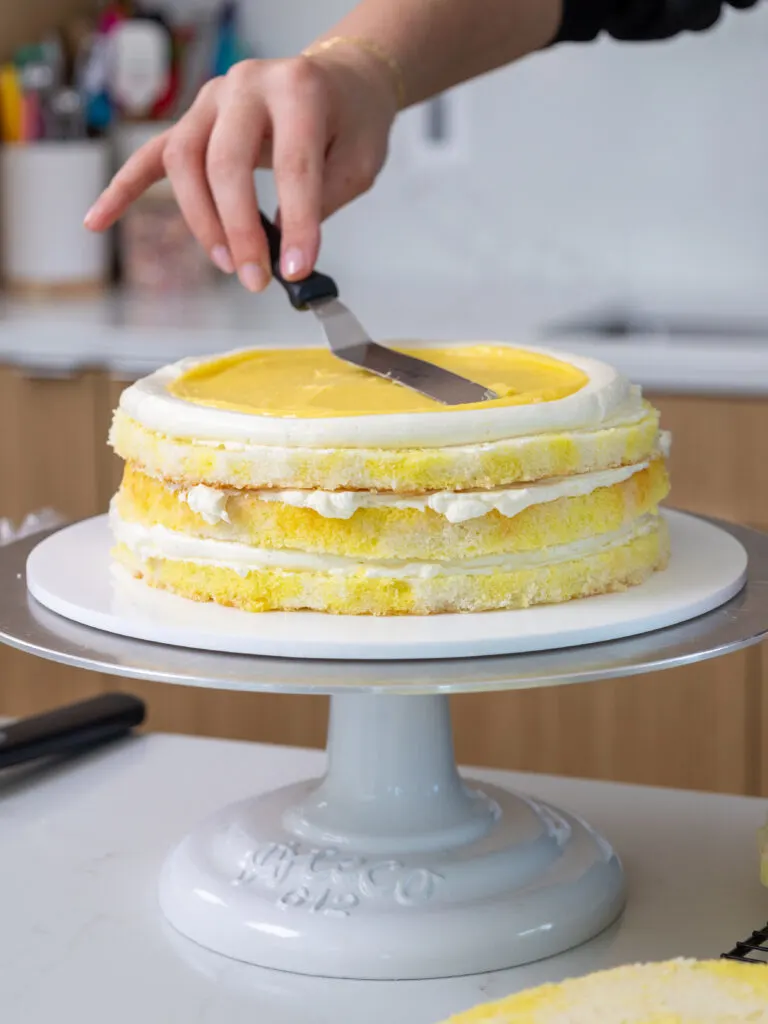
If you torte the layers like I did, alternate filling the cake with layers of lemon curd and a thick layer of frosting.
Once all the layers are stacked, gently press down on top of the cake with both of your hands to help them settle and to press out any trapped air between the cake layers.
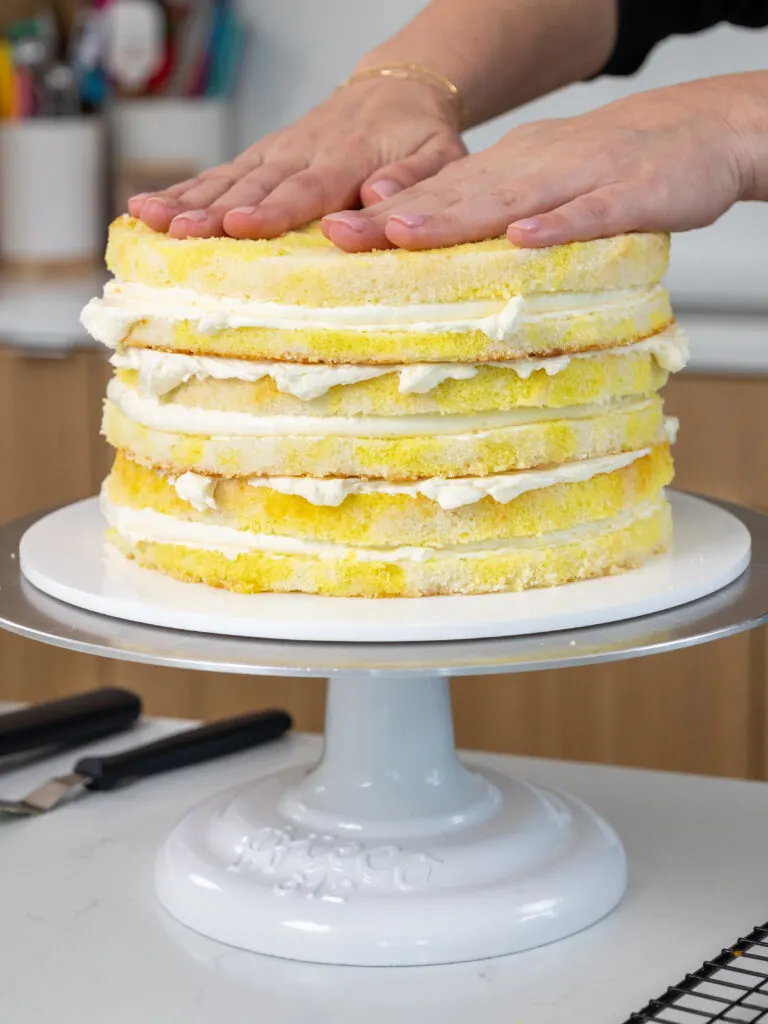
Step 5: Chill and Crumb Coat the Cake
Chill the cake in the freezer for 5-10 minutes to prevent the layers from sliding, then add a thin coat of frosting around the cake that fully covers the cake layers.
Smooth using a large offset spatula and/or bench scraper, then chill the cake again in the fridge (30 minutes) or freezer (10 minutes) until the frosting is firm to the touch.
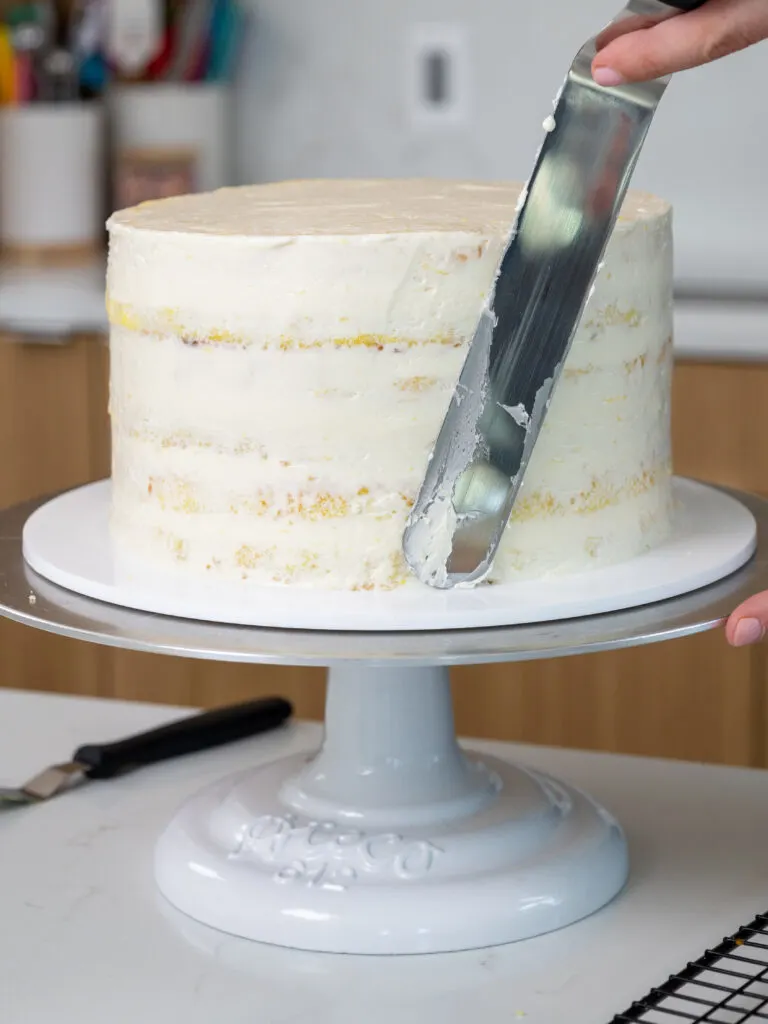
Step 6: Add the Second Layer of Frosting & Decorate
Then add a second layer of frosting to the cake with the remaining buttercream. Use a large offset spatula to give the frosting a textured look.
Use a small offset spatula to add swipes of lemon curd around the cake and blend it into the frosting.
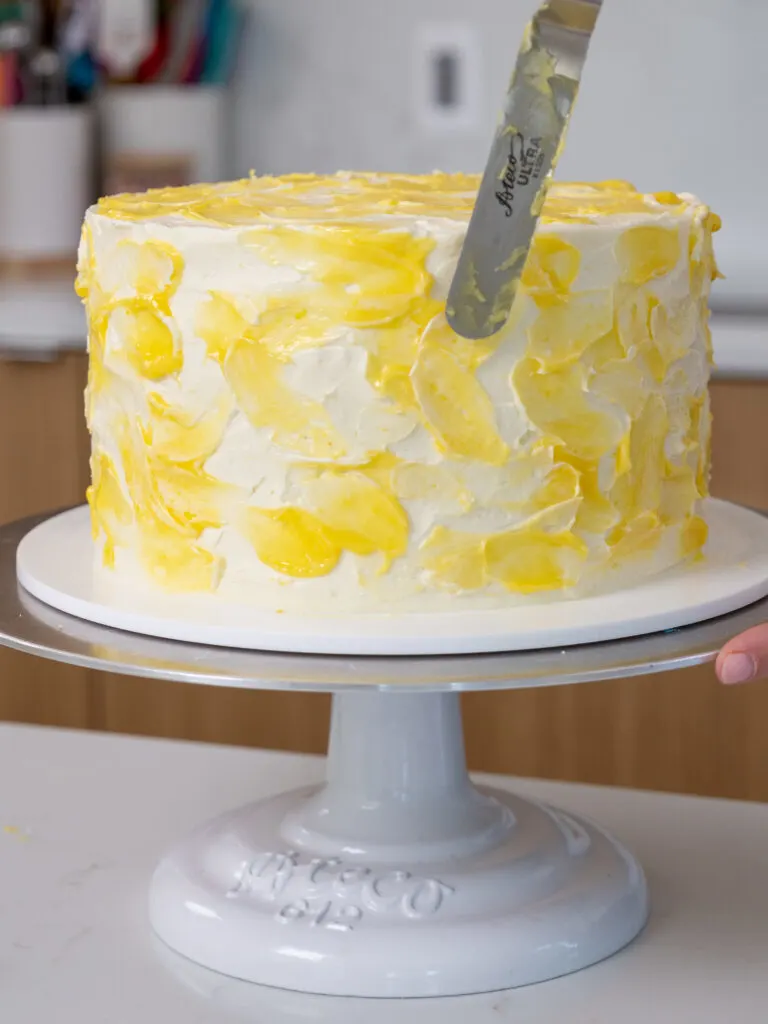
Then decorate as desired and enjoy! I added some dried lemon slices as a garnish.
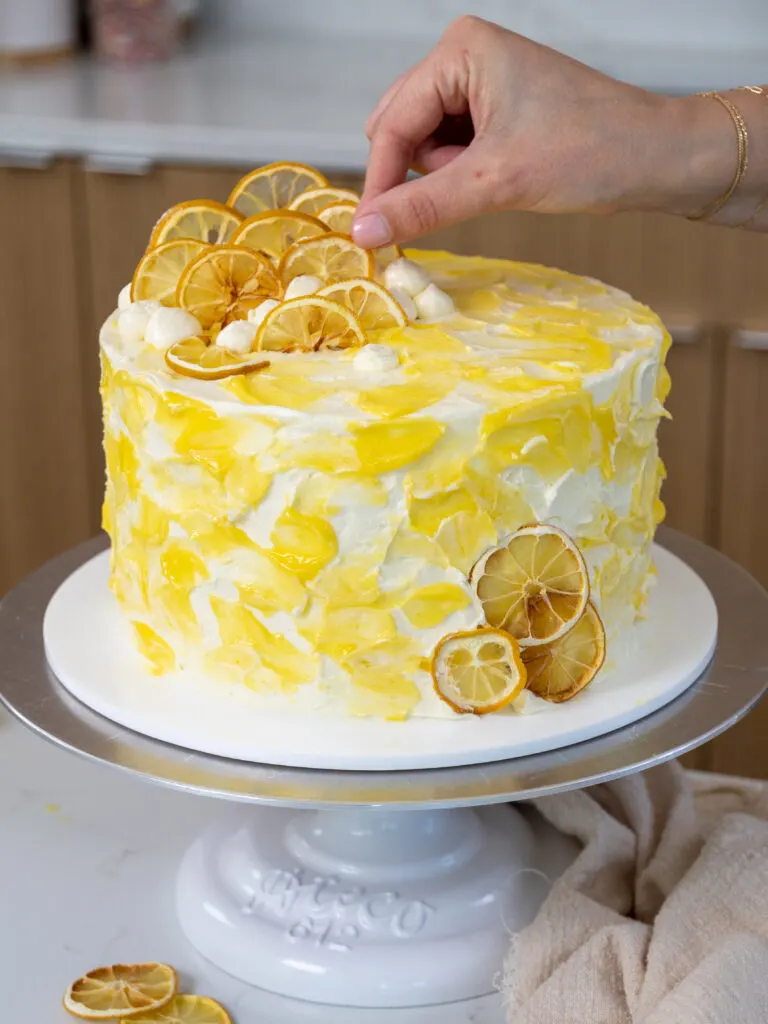
Substitutions and Swaps – Lemon Cake Layers
This recipe uses quite a few ingredients and I know you might not have them all on hand. Or if you have food allergies or restrictions, I’ve got you covered.
Below are some swaps and substitutions that can be made in this cake recipe.
- Cake Flour – This recipe turns out best with cake flour, but you can use a gluten free flour blend if needed or all-purpose flour if that’s all you have on hand.
- Granulated Sugar – I do not recommend reducing the amount of sugar because it will change the texture of the cake layers.
- Unsalted Butter – If you only have salted butter on hand, you can use it in place of the unsalted butter in this recipe. Just be sure to omit the salt that this cake recipe calls for. You can also use vegan butter in its place (and also omit the salt)!
- Egg whites – I like to use the pasteurized egg whites that come in a carton, but you can also use 7 fresh egg whites or 4 whole, large eggs. If you have an egg allergy you can try using flaxseed eggs or an egg replacer.
- Buttermilk – You can also use full-fat yogurt, sour cream, or an alternative yogurt or milk (almond, soy, oat) if you’re dairy free.
- Vegetable Oil – Any flavorless oil can be used in this recipe. Canola or even sunflower oil would work great!
Substitutions and Swaps – Lemon Buttercream
- Unsalted Butter – If you only have salted butter on hand, you can use it in place of the unsalted butter. Just be sure to omit the salt that this frosting recipe calls for. You can also use vegan butter in its place (and omit the salt)!
- Granulated Sugar – I like my SMBC to be a little bit sweet, so I add in slightly more granulated sugar than most SMBC recipes call for. If you want the frosting to be less sweet, you can reduce the sugar in the frosting by 1/2 cup.
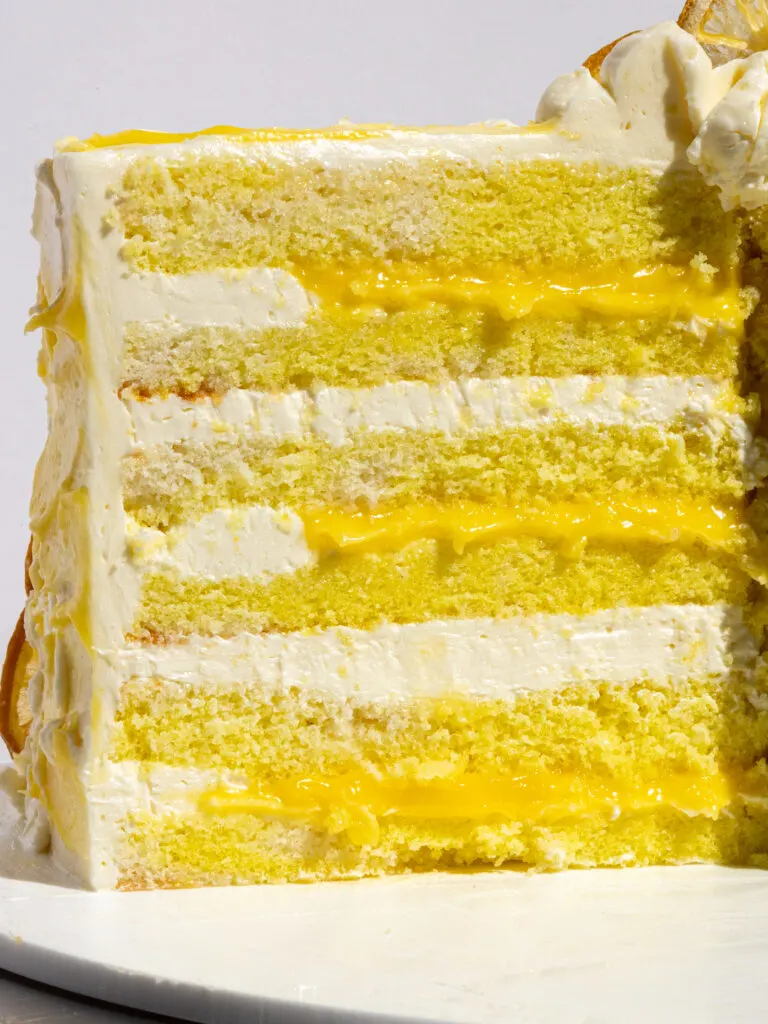
Making This Cake in Advance and Storage Tips
I highly recommend making the components of this cake in stages. It breaks the process up and makes it so much more approachable!
The lemon curd can be made up to a month in advance and stored in the fridge. Just be sure you save the egg whites to make the Swiss meringue buttercream.
The cake layers can also be made in advance and frozen for up to a month. They taste just as great when they’re frozen as when they’re freshly baked, I promise!
You can make the frosting ahead of time or save any leftover frosting. It can be stored in an airtight container in the fridge for up to a month.
Be sure to give the frosting a good stir once it thaws to get the consistency nice and smooth again.
If you cut into the cake and have leftovers, use any remaining frosting to cover the cut section to keep it moist and store it in the fridge for up to a week.

Tips for Making the Best Lemon Curd Cake
- Properly measure your flour. Either spoon it into the cup measure, then level with a knife or use a kitchen scale to measure your dry ingredients.
- Ingredients at room temp mix together better, so be sure to set out any cold ingredients ahead of time.
- Chill the cake layers in the freezer for about 20 minutes before assembling the cake. This makes them easier to stack and frost.
- Level the room temperature or thawed cake layers with a serrated knife to make them easier to stack and fill.
- Chill the cake before adding on the crumb coat. This will help lock all the lemon curd filling in place and prevent the cake layers from sliding.
- If your cake layers do seem to be sliding, insert a wooden dowel or chopstick through the center of the cake to help keep the layers in place.
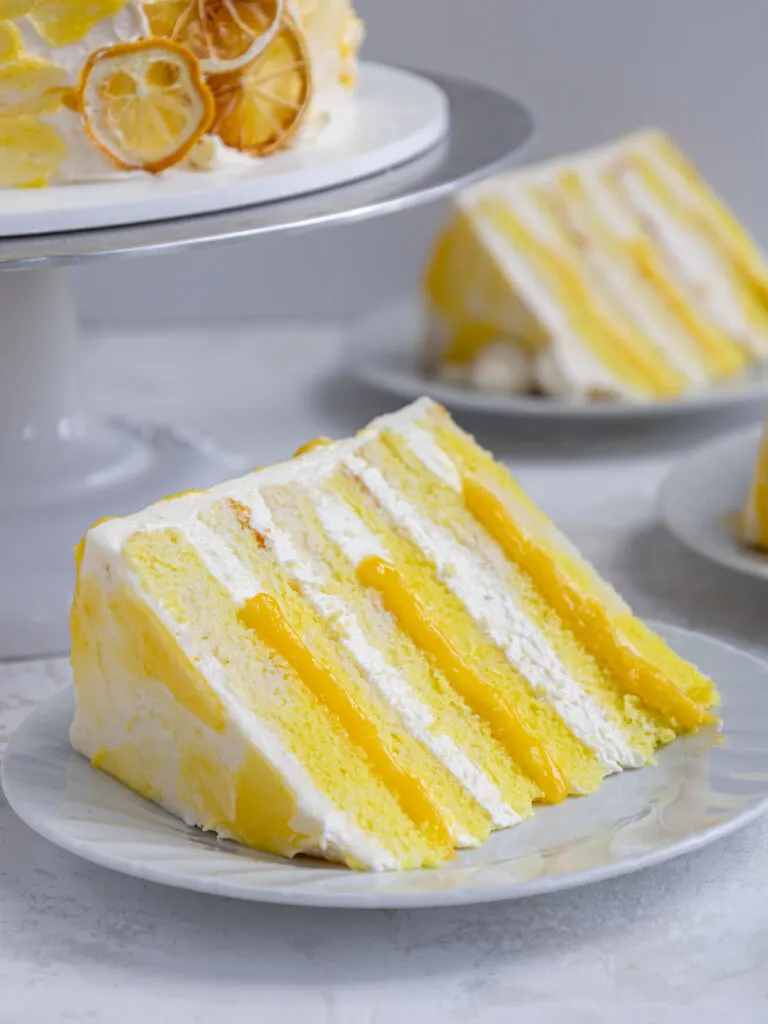
Let Me Know What You Think!
If you make this lemon curd cake recipe, I’d love to hear what you think of it! Let me know by leaving a rating and comment below.
Tag me @chelsweets and use #chelsweets if you share on social media so that I can see your amazing creations.
Other Recipes You Might Like:
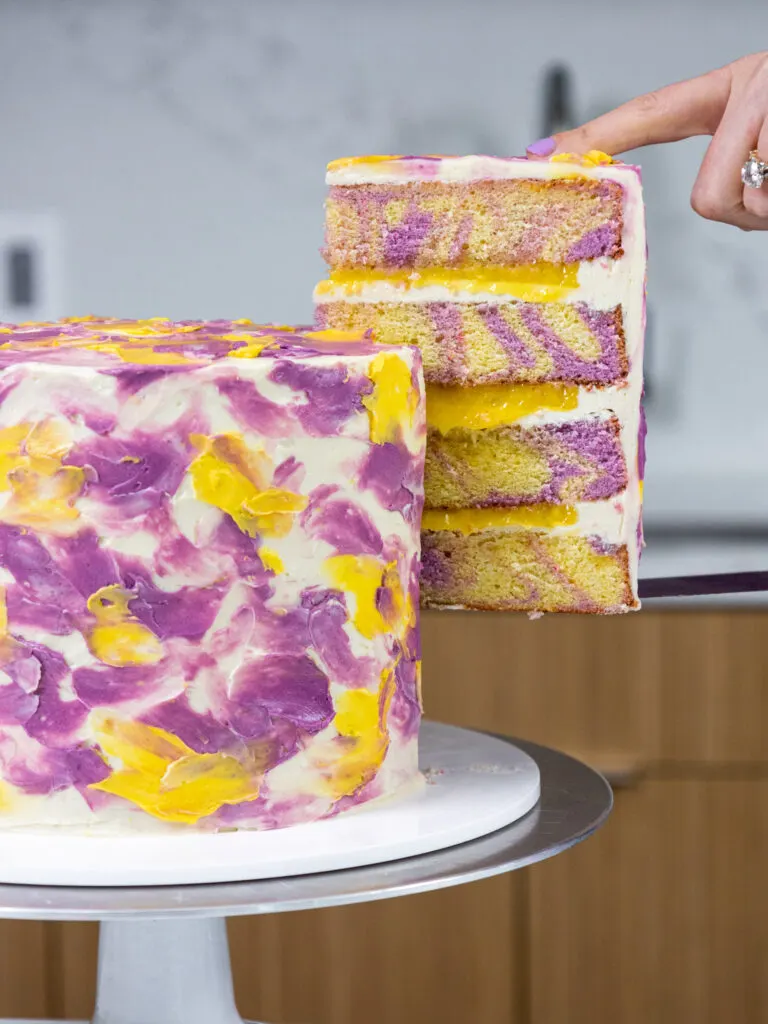
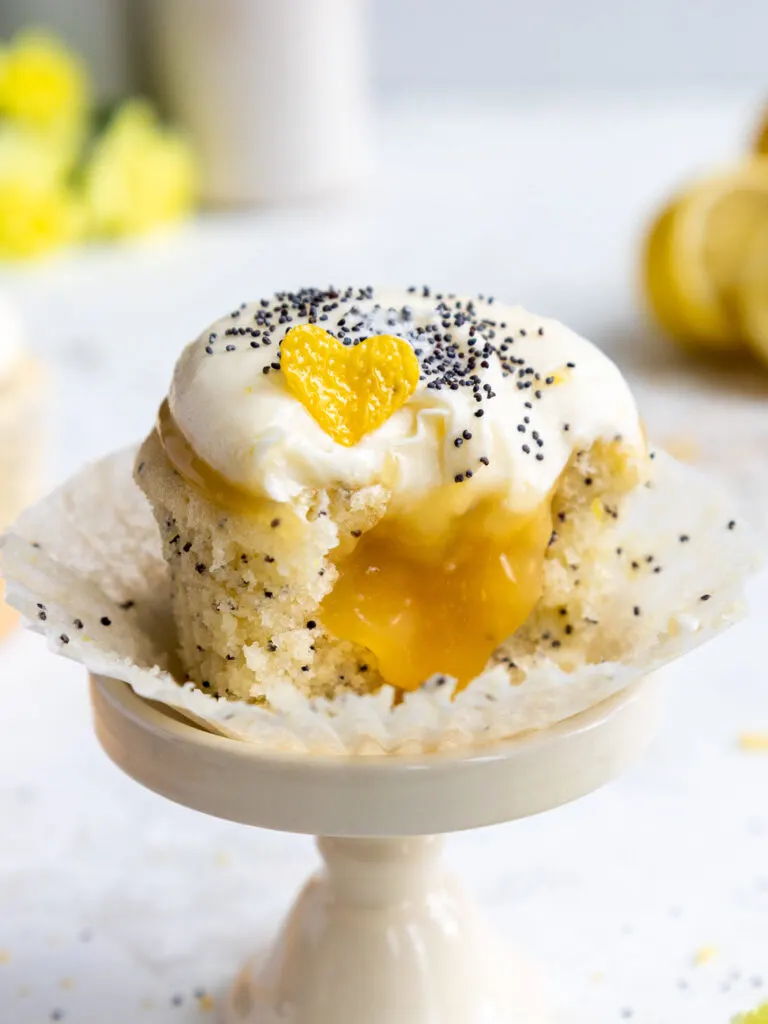

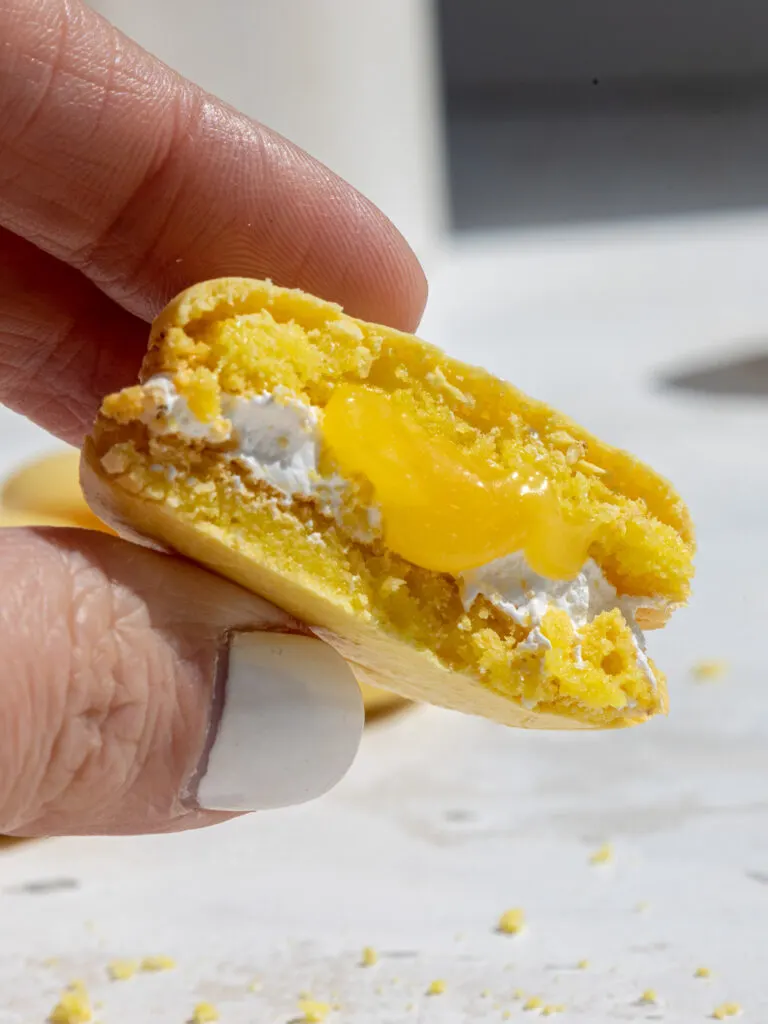
Lemon Curd Cake

This lemon curd cake is so delicious and has the perfect balance of flavor between the bright, tart lemon curd and fluffy cake layers and frosting!
Ingredients
Lemon Curd
- 1 cup granulated sugar (200g)
- 2 tbsp lemon zest - zest of 2 large lemons (10g)
- 6 large egg yolks (150g)
- 1/2 cup lemon juice - juice of 2 large lemons (120g)
- 1/2 cup butter unsalted, cold and cut into Tbsp-sized pieces (113g)
Lemon Cake Layers
- 3 cups granulated sugar (600g)
- 2 Tbsp lemon zest - about 2 large lemons (10g)
- 3 cups cake flour (360g)
- 2 1/2 tsp baking powder (10g)
- 1 tsp fine salt (6g)
- 1 cup (2 sticks) unsalted butter, room temperature (226g)
- 1 cup pasteurized egg whites from a carton or 7 large egg whites, room temperature (240g)
- 1 1/2 cups buttermilk, room temperature (360g)
- 2 Tbsp vegetable oil (28g)
- 1 tsp vanilla extract (4g)
- yellow gel food coloring (optional)
Lemon Buttercream Frosting
- 8 large egg whites (260g)
- 2 1/2 cups granulated sugar (500g)
- 2 cups (4 sticks) unsalted butter, room temperature (454g)
- Zest of 2 large lemons
- 1/4 cup fresh lemon juice or the juice of 1 large lemon (60g)
- 2 tsp vanilla extract (8g)
- 2 tsp lemon extract (8g)
- 1/2 tsp fine salt (3g)
Optional Garnish
Recommend Equipment
Instructions
Lemon Curd:
- Make the lemon curd first so that it has time to cool and thicken. Separate 6 yolks from the whites and set aside the egg whites to make the Swiss meringue buttercream later. Make sure the eggs are cold when you separate them; it makes the process easier.
- Add 1 cup of sugar into a small saucepan. One quick thing to note! When making the lemon curd, it's best to use a saucepan that's ceramic as opposed to metal. Some metal pans and sometimes even metal whisks can give the curd a metallic taste.
- Zest 2 lemons into the saucepan and massage the zest into the sugar with your fingertips. This helps release the oil in the zest and gives this curd a bright, citrusy flavor.
- Add in 6 egg yolks and whisk the mixture together until combined. Then mix in the juice of 1/2 cup of fresh lemon juice.
- Heat on medium-low, stirring constantly with a wire whisk until the mixture thickens. It should be thick enough to coat the back of a spoon and keep its shape. This usually takes me 5-7 minutes.
- Remove the pan from heat, then add in 1/2 cup of cold butter that's been cut into smaller pieces. Mix until the butter is fully melted, and the ingredients are combined.
- Pour the lemon curd through a fine mesh strainer into a separate bowl to remove any bits of cooked egg, clumps of zest, or lemon seeds. This gives it a perfectly smooth texture! Set aside to cool. If you make the curd in advance, cover it flush with plastic wrap to prevent it from forming a skin and store in the fridge for up to a month.
Lemon Cake Layers:
- Then it's time for the cake layers! Preheat the oven to 350°F/175°C and line and grease three, 8-inch cake pans with parchment rounds and non-stick spray.
- Add 3 cups sugar and zest 2 large lemons into a large bowl or the bowl of a stand mixer. Use your fingertips to massage the zest into the sugar to help release the oil in the zest.
- Add 3 cups cake flour, 2 1/2 tsp baking powder, and 1 tsp salt into the bowl with the sugar and whisk together until combined.
- Then mix in 1 cup (2 sticks) of unsalted butter with a paddle attachment or hand mixer on a low speed. Continue to mix until no large chunks of butter remain, and the mixture looks like moist sand.
- Mix in 1 cup of egg whites on a medium speed until incorporated. The batter should be quite thick at this point.
- Then add in 1 1/2 cups buttermilk, 2 Tbsp vegetable oil, and 1 tsp vanilla extract. Mix on a low speed until incorporated.
- Scrape down the sides and bottom of the bowl with a rubber spatula, then beat on medium speed for about 30 seconds to make sure everything is properly mixed together. This cake recipe uses the reverse creaming method, so this step is important to help give the cake layers a lighter texture.
- Pour half of the cake batter (about 900g) into a separate bowl. Use a small drop of gel food coloring to color one bowl of batter light yellow.
- Alternate pouring the uncolored and yellow batter into the prepared pans to give the cake layers a marbled look. Use a butter knife or a small offset spatula to swirl the batter together. Bake for 33-36 minutes or until a toothpick comes out with a few moist crumbs. Let the cake layers cool in the pans for 15 minutes, then run a small offset spatula around the perimeter of the pan to separate the cake from the pan.
- Flip the cake layers onto a wire rack to cool. Use a serrated knife to level the tops and remove the caramelization around the sides of the layers. I also like to torte the cake layers horizontally (see picture above) to create 6 thinner cake layers, but this is optional. You can also trim the layers, then wrap and freeze them if you're making them in advance.
- If you make these cake layers in advance and freeze them, let them thaw for about 20 minutes before assembling your cake. The cake layers should still be cold to the touch, which will make it easier to assemble your cake.
Lemon Swiss Meringue Frosting:
- While the cake layers bake and cool, make the lemon buttercream frosting.
- Before making the frosting, be sure to thoroughly clean your mixing bowl. If there’s any grease it can make it difficult to whip up the meringue.
- In a medium sized pot, add 1 inch of water and bring to a simmer.
- Add 8 egg whites (use the 6 egg whites saved from making the lemon curd, plus two additional egg whites) and 2 1/2 cups of granulated sugar into a large metal bowl.
- Place the bowl on top of the pot filled with simmering water. The bowl should create a seal over the pot. Make sure the water isn’t actually touching the bottom of the bowl, or it can cook the egg whites.
- Whisk the mixture constantly for about 3 minutes, until it reaches 160°F / 71°C. You can test the mixture to see if it’s ready by rubbing a tiny bit between your fingertips. The sugar should be fully dissolved, and it should feel super smooth and hot to the touch.
- Lift the bowl away from the pot and dry the bottom with a towel. Pour the mixture into the bowl of a stand mixer and beat on a medium-high speed with a whisk attachment. Mix for about 10 minutes, or until you have stiff, glossy peaks.
- Mix in 2 cups of unsalted butter at a medium speed, 1 stick at a time. The frosting should have a thick, whipped consistency at this point. If it looks lumpy or broken, keep mixing until it looks smooth and thick. If it doesn't seem to come together after an additional 10 minutes of mixing, check out my Swiss meringue buttercream troubleshooting guide.
- Once the consistency is right, swap out the whisk attachment for a paddle attachment and add in the zest of 2 large lemons, 1/4 cup fresh lemon juice, 2 tsp vanilla extract, 2 tsp lemon extract, and 1/2 tsp fine salt.
- To make the frosting extra smooth, swap out the whisk attachment for a paddle attachment and continue mixing on a low speed for a couple minutes.
- Place half of the frosting in a large piping bag and cut a 1-inch opening at the base of the bag. Set aside.
Assembling this Lemon Curd Cake:
- Stack and frost the cake layers on a greaseproof cake board or flat plate using a dab of frosting to help stick the first cake layer to the board.
- Spread a thin layer of buttercream on top of each cake layer. Pipe a thick ring of buttercream around the edge of the cake layer and fill the center with lemon curd. I like to add about 1/3 cup of lemon curd between each layer. Make sure you reserve about 1/4 cup of lemon curd to decorate the cake later. Note: If you torte the layers like I did, alternate filling the cake with layers of lemon curd and a thick layer of frosting.
- Once all the layers are stacked, gently press down on top of the cake with both of your hands to help them settle and to press out any trapped air between the cake layers.
- Chill the cake in the freezer for 5-10 minutes to prevent the layers from sliding, then add a thin coat of frosting around the cake that fully covers the cake layers. Smooth using a large offset spatula and/or bench scraper, then chill the cake again in the fridge (30 minutes) or freezer (10 minutes) until the frosting is firm to the touch.
- Then add a second layer of frosting to the cake with the remaining buttercream. Use a large offset spatula to give the frosting a textured look. Use a small offset spatula to add swipes of lemon curd around the cake and blend it into the frosting. Then decorate as desired and enjoy! I added some dried lemon slices as a garnish.
Notes
How Many People Does This Cake Feed?
This cake feeds about 24 people. For more information on cake sizes and servings, check out my cake portion guide.
Substitutions and Swaps
If you need to make any substitutions or swaps in this recipe, please check out the section on ingredient substitutions in the post above.
Making this Lemon Curd Layer Cake in Different Sizes
One batch of batter is about 1800g or 10 cups, so I add roughly 600g to each of my cake pans when using 3, 8-inch cake pans.
You can also use one batch of batter to make 2, 9-inch cake layers or 4, 6-inch cake layers. Bake time will be a few minutes longer at 350 F / 175 C.
If you want to make a tiered cake with this recipe, check out my cake batter calculator to see how many batches of batter you'll need.
This recipe can also be used to make a lemon curd sheet cake! One batch will make a 1, 9 x13-inch cake layer that's about 1.5 inches tall once leveled.
Bake for 45-55 mins at 350 F / 175 C, or until a toothpick inserted in the center comes out with a few moist crumbs. Bake time can vary a lot based on the type of pan you use, if you use heating cores, and your oven. I recommend using heating cores if you have them, they help sheet cake layers bake more evenly and quickly.
Once the sheet cake is baked and cooled, spread a thick layer of lemon curd straight onto the cake, chill the cake in the freezer for 10 minutes to help it set, then top it with buttercream.
For more details on how to convert this cake recipe and others into sheet cakes, check out my sheet cake guide.
If you want to make lemon curd cupcakes, bake them at 350F / 175C for 18-21 minutes. One batch of batter will make about 3 dozen cupcakes (yield will vary based on the size of your liners).
Tips for Making the Best Lemon Curd Layer Cake
- Properly measure your flour (spoon into the cup measure, then level) or use a kitchen scale to measure your dry ingredients.
- Ingredients at room temperature mix together better. Set out any cold ingredients ahead of time.
- Chill the cake layers in the freezer for about 20 minutes before assembling the cake. This makes it a lot easier to stack and frost.
- Chill the entire cake before adding on the crumb coat. This will help lock all the lemon curd filling in place and prevent the cake layers from sliding.
- If your cake layers seem to be sliding, insert a wooden dowel or chopstick through the center of the cake to help keep the layers in place.
- If your cake layers turn out less than perfect, read my cake troubleshooting guide to see where things might've gone awry.
Making This Cake in Advance and Storage Tips
I highly recommend making the components of this cake in stages. It breaks the process up and makes it so much more approachable!
The lemon curd can be made up to a month in advance and stored in the fridge. Just be sure you save the egg whites to make the Swiss meringue buttercream.
The cake layers can also be made in advance and frozen. They taste just as great when they're frozen as when they're fresh, I promise!
In addition, you can make the frosting ahead of time or save any leftover frosting. It can be stored in an airtight container in the fridge for up to a month.
Be sure to give the frosting a good stir once it thaws to get the consistency nice and smooth again.
If you cut into the cake and have leftovers, use any remaining frosting to cover the cut section to keep it moist and store it in the fridge for up to a week.
Nutrition Information
Yield
24Serving Size
1Amount Per Serving Calories 505Total Fat 13gSaturated Fat 5gTrans Fat 0gUnsaturated Fat 8gCholesterol 90mgSodium 396mgCarbohydrates 91gFiber 2gSugar 70gProtein 8g

Tammy
Monday 23rd of September 2024
Was using the lemon curd portion of this recipe. It’s been in the fridge overnight and I still have soup. Any way to save this? I made a batch of 4 times the amount for a wedding cake this weekend.
Jeff
Monday 2nd of September 2024
Meringue didn’t come together in spite of refrigerating it. Aside from that—it didn’t taste that great.
The cakes were crumbly—and really didn’t taste that great.
Will never use this recipe again.
Vanessa
Sunday 1st of September 2024
This cake recipe is absolutely perfect!! All your recipes work out perfectly! I’ve used the vanilla cake recipe and this one for tiered cakes and people go nuts over them! I’m going to try make this with orange juice and zest high a passion fruit ganache next. Thank you so much for sharing with us!
wanda
Tuesday 16th of July 2024
when adding egg whites to the dry ingreds, do they first need to be whipped to soft peaks, or just pour unbeaten whites to dry? Also, it sez that instead of egg whites you can use 4 whole eggs. Which is better? I am making tiered wedding cake for my daughter.
Jasmine Standen
Sunday 2nd of June 2024
Hi, I’m hoping to make this for my mums 50th birthday. She had around 30 people coming and I saw this serves around 24. Would I be able to divide this recipe by 3 and make another layer. I’d rather have too much than not enough. Would it stack ok?
Chelsweets
Tuesday 4th of June 2024
Hi Jasmine,
Great question, and yes!! You can totally do that, that's what I'd recommend! It should stack just fine!! Hope that helps and that your Mom's cake turns out amazing!! :)